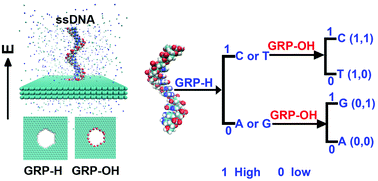Computational investigation on DNA sequencing using functionalized graphene nanopores
Abstract
Fast, low-cost and reliable DNA sequencing is one of the most desirable innovations in recent years, which can pave the way for high throughput, label-free and inexpensive personalized genome sequencing techniques. Although graphene-based nanopore devices hold great promise for next-generation DNA sequencing, it is still a challenging problem to detect different DNA sequences efficiently and accurately. In the present work, the translocation of four homogeneous DNA strands (i.e., poly(A)20, poly(C)20, poly(G)20, and poly(T)20) through the functionalized graphene nanopores is investigated by all-atom molecular dynamic simulations. Interestingly, it is found that the four types of bases could be identified by different ionic currents when they pass through the hydrogenated and hydroxylated pores. For the hydrogenated nanopore, the difference in the ionic current for the four bases is mainly attributed to the different electrostatic interactions between the base and the ion. For the hydroxylated nanopore, apart from the electrostatic interactions, the position of a nucleotide inside the nanopore and the dwell time of an ion around the nucleotide also play an important role in the ionic current. The present study could be helpful to better design a novel device for DNA sequencing in the future.



 Please wait while we load your content...
Please wait while we load your content...